Uses
Enoxaparin is used to prevent and treat harmful blood clots. This helps to reduce the risk of a stroke or heart attack. This medication helps keep your blood flowing smoothly by lowering the activity of clotting proteins in the blood. Enoxaparin is an anticoagulant, also known as a "blood thinner." It is a type of heparin.Conditions which increase your risk of developing blood clots include certain types of surgeries (such as knee/hip replacement, abdominal), long periods of being immobile, certain types of heart attack, and a specific type of chest pain called unstable angina. For some medical conditions, enoxaparin may be used in combination with other "blood thinners.
How to use Lovenox Syringe
Read the Patient Information Leaflet if available from your pharmacist before you start using enoxaparin and each time you get a refill. Ask your health care professional how to prepare and use this medication. If you have any questions, ask your doctor or pharmacist.
Inject this medication under the skin as directed by your doctor, usually once or twice a day. The injection is given in the abdomen (at least 2 inches from your belly button). Do not inject into a muscle. The dosage and length of treatment are based on your medical condition, age, weight, and response to treatment.
Before using, check this product for particles or discoloration. If either is present, do not use the liquid. Before injecting each dose, clean the skin you are going to inject into (the injection site) with rubbing alcohol. Change the injection site each time to lessen injury under the skin. To lessen bruising, do not rub the injection site after a shot. Learn how to store and discard medical supplies safely.
This medication may also be given by injection into a vein by a health care professional, as directed by your doctor.
Use this medication regularly to get the most benefit from it. To help you remember, use it at the same time(s) each day.
Side Effects
See also Warning section.
Mild irritation, pain, bruising, redness, and swelling at the injection site may occur. Tiredness or fever may also occur. If any of these effects last or get worse, tell your doctor or pharmacist promptly.
Remember that this medication has been prescribed because your doctor has judged that the benefit to you is greater than the risk of side effects. Many people using this medication do not have serious side effects.
This medication can cause bleeding if its effect on your blood clotting proteins is too much. Tell your doctor right away if you have any serious signs of bleeding, including: unusual pain/swelling/discomfort, unusual or prolonged bleeding, unusual or easy bruising, dark urine, black stools, severe headache, confusion, vision changes, unusual dizziness, fainting, seizures, weakness, numbness.
A very serious allergic reaction to this drug is rare. However, get medical help right away if you notice any symptoms of a serious allergic reaction, including: rash, itching/swelling (especially of the face/tongue/throat), severe dizziness, trouble breathing.
This is not a complete list of possible side effects. If you notice other effects not listed above, contact your doctor or pharmacist.
In the US -
Call your doctor for medical advice about side effects. You may report side effects to FDA at 1-800-FDA-1088 or at www.fda.gov/medwatch.
In Canada - Call your doctor for medical advice about side effects. You may report side effects to Health Canada at 1-866-234-2345.
Warnings
People using this medication may bleed near the spinal cord after certain spinal procedures. Bleeding in this area can cause paralysis that lasts a long time or could become permanent. Talk with your doctor about the benefits and risks before any spinal procedure. Your doctor may direct you to stop this medication for a certain amount of time before and after the procedure. Carefully follow your doctor's directions.
The risk of bleeding may be higher if you have a deformed spine, or have had spinal procedures/surgery before (such as epidural catheter placement, difficult epidural/spinal puncture), or are taking other drugs that can cause bleeding/bruising (including antiplatelet drugs such as clopidogrel, "blood thinners" such as warfarin/rivaroxaban, nonsteroidal anti-inflammatory drugs-NSAIDs such as ibuprofen). Tell your doctor right away if you notice symptoms such as back pain, leg numbness/tingling/weakness, loss of control of the bowels or bladder (incontinence).
Precautions
Before using enoxaparin, tell your doctor or pharmacist if you are allergic to it; or to heparin or pork products; or if you have any other allergies. This product may contain inactive ingredients, which can cause allergic reactions or other problems. Talk to your pharmacist for more details.
Before using enoxaparin, tell your doctor or pharmacist your medical history, especially of: artificial heart valve(s), kidney disease, liver disease, bleeding/blood problems (such as low platelet counts), low platelet counts after previous heparin treatment, stroke, high blood pressure, certain eye problems (such as diabetic retinopathy), certain stomach/intestinal problems (such as active or recent ulcers), recent spinal procedure or puncture, spine problems (such as spinal deformity), recent eye/brain/spinal cord surgery.
Limit alcohol while taking this drug because it may increase the risk of stomach bleeding.
Before having surgery, tell your doctor or dentist about all the products you use (including prescription drugs, nonprescription drugs, and herbal products).
To lower the chance of getting cut, bruised, or injured, use caution with sharp objects like razors and nail cutters, and avoid activities such as contact sports.
Older adults may be more sensitive to the side effects of this drug, especially bleeding.
During pregnancy, this medication should be used only when clearly needed. Discuss the risks and benefits with your doctor.
It is unknown if this drug passes into breast milk. Consult your doctor before breastfeeding.
Interactions
Drug interactions may change how your medications work or increase your risk for serious side effects. This document does not contain all possible drug interactions. Keep a list of all the products you use (including prescription/nonprescription drugs and herbal products) and share it with your doctor and pharmacist. Do not start, stop, or change the dosage of any medicines without your doctor's approval.
A product that may interact with this drug is: mifepristone.
This medication is sometimes used together with other drugs that have "blood thinning" or anti-platelet effects such as aspirin, clopidogrel, or warfarin. When these combinations are prescribed by your doctor, you will require closer monitoring to minimize your risk of bleeding. Keep all medical and lab appointments.
Check all prescription and nonprescription medicine labels carefully since many medications contain pain relievers/fever reducers (NSAIDs such as ibuprofen, naproxen, or aspirin) which can increase the risk of bleeding/anti-platelet effect when used with enoxaparin. However, if your doctor has told you to take low-dose aspirin to prevent heart attack or stroke (usually 81-162 milligrams a day), you should keep taking the aspirin unless your doctor tells you not to. Ask your doctor or pharmacist for more details.
Overdose
If someone has overdosed and has serious symptoms such as passing out or trouble breathing, call 911. Otherwise, call a poison control center right away. US residents can call 1-800-222-1222. Canada residents can call 1-844-764-7669. Symptoms of overdose may include: excessive bleeding and bruising.
Do not share this medication with others.
Lab and/or medical tests (such as complete blood count, anti-factor Xa blood levels) should be done while you are using this medication. Keep all medical and lab appointments. Consult your doctor for more details.
If you miss a dose, use it as soon as you remember. If it is near the time of the next dose, skip the missed dose. Use your next dose at the regular time. Do not double the dose to catch up.
Store at room temperature away from light. Discard the multiple dose vials 28 days after the first use. Keep all medications away from children and pets.
Do not flush medications down the toilet or pour them into a drain unless instructed to do so. Properly discard this product when it is expired or no longer needed. Consult your pharmacist or local waste disposal company.
Images

Lovenox 100 mg/mL subcutaneous syringe
Color: colorlessShape: Imprint:This medicine is a colorless, clear, solution
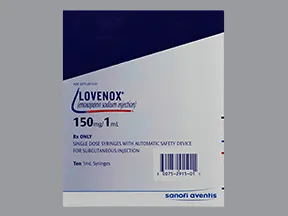
Lovenox 150 mg/mL subcutaneous syringe
Color: colorlessShape: Imprint:This medicine is a colorless, clear, solution
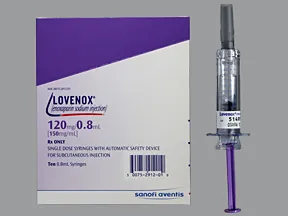
Lovenox 120 mg/0.8 mL subcutaneous syringe
Color: colorlessShape: Imprint:This medicine is a colorless, clear, solution

Lovenox 80 mg/0.8 mL subcutaneous syringe
Color: colorlessShape: Imprint:This medicine is a colorless, clear, solution
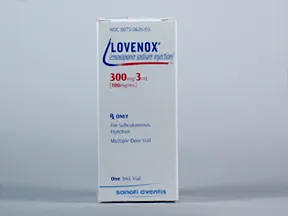
Lovenox 300 mg/3 mL subcutaneous solution
Color: colorlessShape: Imprint:This medicine is a colorless, clear, solution
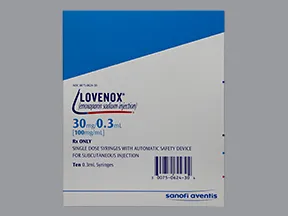
Lovenox 30 mg/0.3 mL subcutaneous syringe
Color: colorlessShape: Imprint:This medicine is a colorless, clear, solution
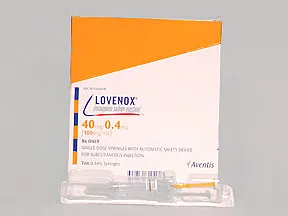
Lovenox 40 mg/0.4 mL subcutaneous syringe
Color: colorlessShape: Imprint:This medicine is a colorless, clear, solution

Lovenox 60 mg/0.6 mL subcutaneous syringe
Color: colorlessShape: Imprint:This medicine is a colorless, clear, solution
Are you currently using Lovenox Syringe?
This survey is being conducted by the WebMD marketing sciences department.
Selected from data included with permission and copyrighted by First Databank, Inc. This copyrighted material has been downloaded from a licensed data provider and is not for distribution, except as may be authorized by the applicable terms of use.
CONDITIONS OF USE: The information in this database is intended to supplement, not substitute for, the expertise and judgment of healthcare professionals. The information is not intended to cover all possible uses, directions, precautions, drug interactions or adverse effects, nor should it be construed to indicate that use of a particular drug is safe, appropriate or effective for you or anyone else. A healthcare professional should be consulted before taking any drug, changing any diet or commencing or discontinuing any course of treatment.